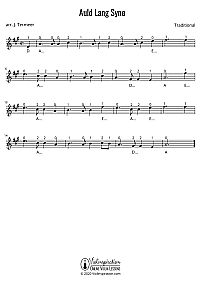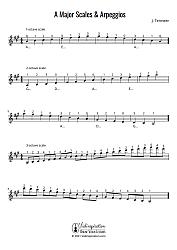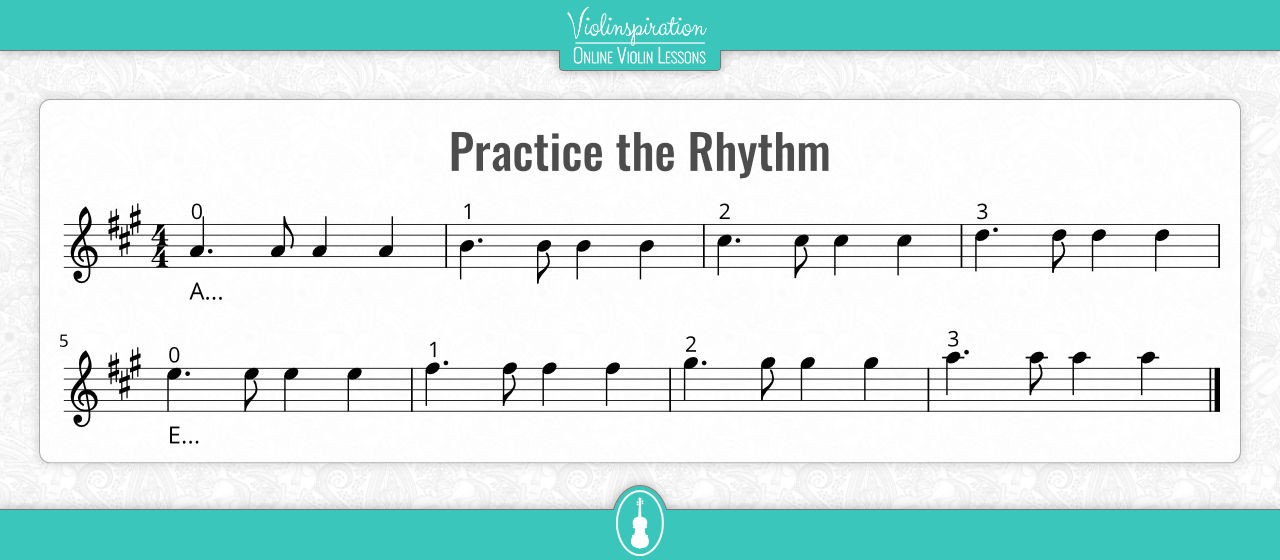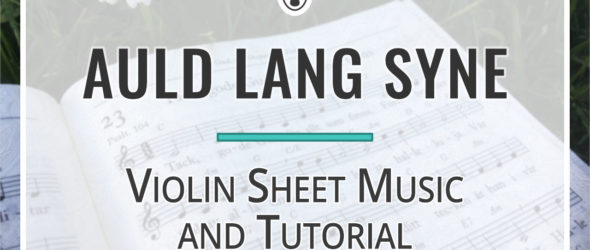Download Auld Lang Syne violin sheet music for free, and learn how to play the piece.
Auld Lang Syne is a popular folk song that’s easy to play on the violin, even for beginners. Today, I’m sharing free sheet music, and a tutorial with warm-ups that’ll help you learn the piece, no matter what level you play at.

Auld Lang Syne
Free Violin Sheet Music
Auld Lang Syne Song History

Auld Lang Syne is a poem written in 1788 by Robert Burns and then set to an older Scottish folk song.
In English-speaking parts of the world, it’s traditionally sung on New Years’ Eve at midnight to say goodbye to the previous year. Since the lyrics have a theme of farewells, it’s also sometimes played at funerals and graduations.
Auld Lang Syne Violin Sheet Music
Download my free sheet music tailored to beginners below. I make it easy for you to read the music with tabs showing what finger numbers to play and on which string.

Auld Lang Syne
Free Violin Sheet Music
Warm Ups for Auld Lang Syne
It’s important to warm up before practicing any piece on the violin. Here are a few ways you can mentally and physically prepare yourself to learn Auld Lang Syne.
Warm Up with the A Major Scale and Arpeggio
My arrangement of Auld Lang Syne is in A Major. This means there are three sharps in the key signature. Practicing the scale that goes along with whatever music you’re learning will help you improve your technique and learn the music faster.
Download my A Major warm-ups below:

A Major Scales & Arpeggios
Practice the Rhythm
Practice the A Major scale on the rhythm we play in almost every measure of the piece.

Use the full measure’s rhythm on each note of the scale to practice how much bow to use per note, and to create a beautiful sound.
Be sure to keep the rhythm precise, with a big difference between the first long note, and the second short note. We’ll talk more about how to achieve this a little later.
How to Play Auld Lang Syne on Violin
Watch my tutorial video to see me play through the song and to learn some tips that’ll help you master Auld Lang Syne.
Bow Strokes
In Auld Lang Syne, we play detaché and accents.
Detaché is basically the default bow stroke on the violin. It’s not quite a smooth legato, but it’s definitely not a short staccato. We play this bow stroke with all separate bow strokes: down; up; down; up; over and over again.
An accent tells us to emphasize the note it’s written under. An accented note is usually the most important note of the measure. To create an accented sound, think of making your right arm heavier.
Starting on an Upbeat

This piece begins on beat 4 of a measure. We call this an upbeat, or a pickup note. You’ll also notice that the last measure only contains 3 beats, despite the time signature being 4/4. When we have a pickup note, we make up the difference with the last measure. so, 1 beat (pickup) + 3 beats (last measure) = a full measure of 4 beats.
When we begin a piece with an upbeat, we almost always start it on an up bow. Usually the upbeat is “weak,” and the first note of the first full measure is “strong.” Up bows typically sound weaker, or quieter; and down bows are usually stronger, or louder.
Rhythm
We want to play with a very precise rhythm through Auld Lang Syne. We have a “long-short” pattern that repeats over and over. Our goal is to make a large difference between the two lengths. Sometimes, if we forget to focus on the rhythm, it ends up sounding a bit lazy, and the lengths of the notes sound almost equal.
Think about using more bow on the long notes, and less bow on the short notes. That almost always helps me play the correct rhythms!
If you have trouble with the rhythm, try singing through a measure or two before trying to play it. I find that when I’m struggling with something on the violin, singing it helps unlock something and show me what I really want the passage to sound like. Since this is a folk song, singing it feels quite natural!
Vibrato
If you’d like more of a challenge, the long notes give you a great chance to practice vibrato. Adding vibrato will make the notes sound sweeter, and your instrument will really sing.
This is a great challenge if Auld Lang Syne feels a little too easy for you. However, if the music itself is enough of a challenge, don’t worry about adding vibrato yet. It’s a very tricky technique to master, and takes a lot of time. Focus on what you can handle first, and eventually, you’ll work your way up.
Play with an Accompaniment
If you’re a student of Julia’s Violin Academy, make sure to practice this piece with an accompaniment that is available in Beginner Level 3. You can get an additional portion of motivation by watching and practicing it along with Victoria, one of the teachers at JVA – here’s the recording of the “Practice with Victoria” live session.
For those Julia’s Violin Academy members who’d like to learn a bit more challenging version of this tune, here’s Auld Lang Syne in 3rd Position.
Play with my Play-Along Video
Final Note
Auld Lang Syne is a great folk song to learn on the violin, no matter how long you’ve been learning. I hope my easy arrangement helps you learn this beautiful tune. Be sure to download the free pdf score and the scale & arpeggio sheet to get started!

Auld Lang Syne
Free Violin Sheet Music
























